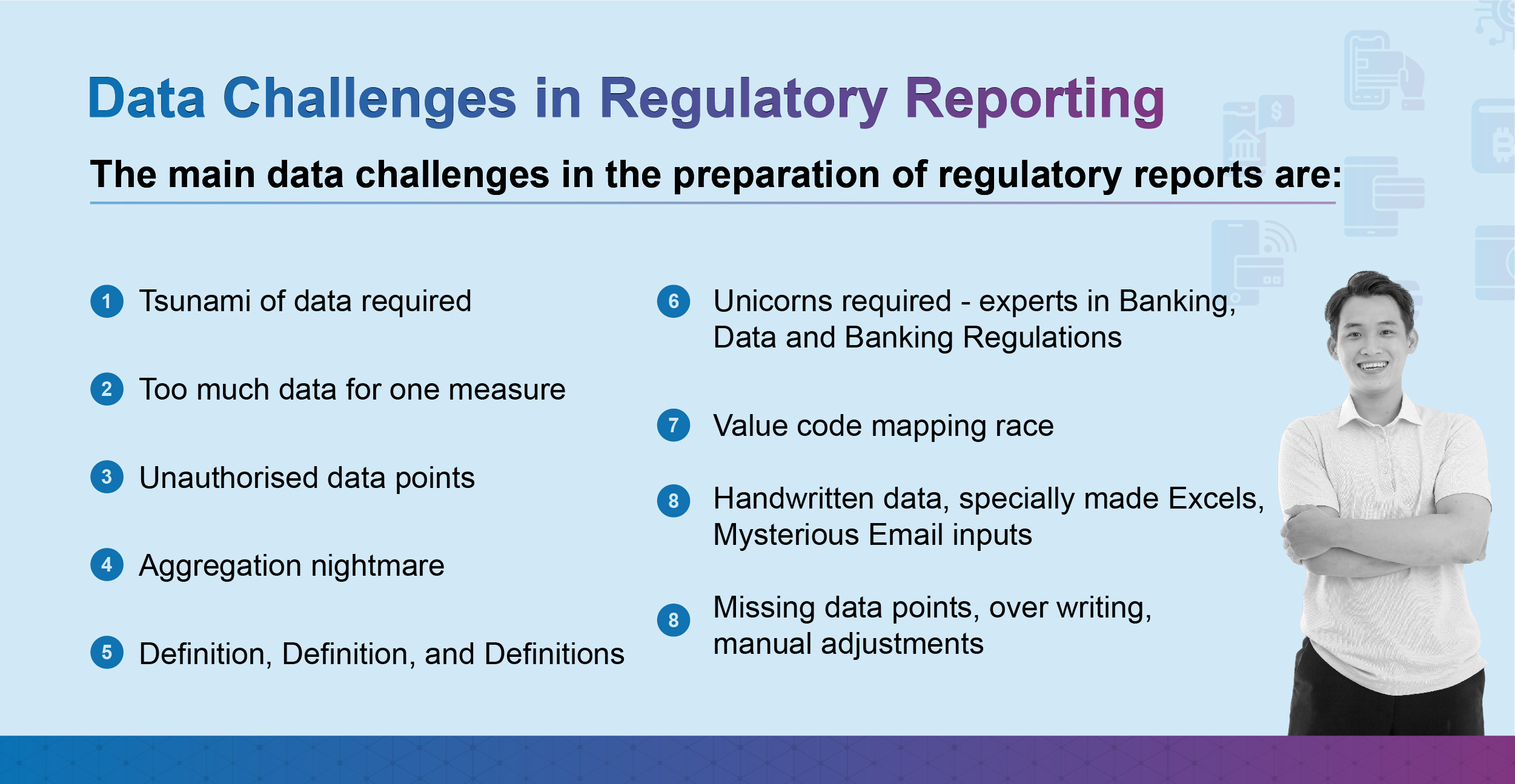Data Challenges in Regulatory Reporting

There are numerous challenges in preparing regulatory reports demonstrating a financial organisation’s compliance with regulations. The foremost of all challenges faced by a financial organisation is securing the right data that is required for preparing such reports.
Let us look at the main data challenges in the preparation of regulatory reports and how financial organisations can overcome these challenges. The main data challenges in the preparation of regulatory reports are:
- Tsunami of data required
- Too much data for one measure
- Unauthorised data points
- Aggregation nightmare
- Definition, Definition, and Definitions
- Unicorns required – experts in Banking, Data and Banking Regulations
- Value code mapping race
- Handwritten data, specially made Excels, Mysterious Email inputs
- Missing data points, over writing, manual adjustments

Tsunami of Data required
Regulatory reports are designed to demonstrate compliance with a regulation or set of regulations. Hence, unlike a normal report, they require enormous quantum and coverage of data. E.g., there are reports that require showing the entire balance sheet of the bank with contract-level information available as supporting information. These kinds of reports require almost the entire banking book of the bank, making them a huge challenge.
Too much data for one measure
Regulatory reports require overview-natured reports requiring measures such as Total Deposits. Such measures require the entire deposit portfolio of the bank, irrespective of the different business lines that source and house such deposits. Additionally, the question of deposits available as collateral, nearing closure in the reporting period, unclaimed deposits, etc.-related exceptions and inclusions complicate the computations. While it may be a single measure or numerical figure in the reports, it may require millions of contracts to be sourced and computed to provide a single numerical figure.
Unauthorised data points
Regulatory reports provide assurance to the regulator that the bank is in compliance with the regulatory requirements and can continue to hold its banking licences. Hence, the data that is used for such regulatory reports must be properly authorised and adequately checked. However, any unauthorised or erroneous data may cause inaccurate reports to be submitted to the regulator. Additional checks and balances are required for data that is provided as manual inputs or feeds.
Aggregation Nightmare
Regulatory reports are looking for overviews. Hence, it requires aggregating accounts, transactions, etc. to a customer or group customer level to identify certain thresholds. There are various other reasons for aggregation as well. Such aggregations are time-consuming or may be repeated multiple times if data arrives late from the source system, a few contracts are excluded due to valid business reasons, etc.
Definition, Definition, and Definitions
In a lighter sense, regulators like to write, and they write really elaborately. Regulators provide the definition of each measure in a report. How much of these definitions are reused is a big question. Many times, while the intention to reuse definitions across reports does exist, they are not being reused. This leads to numerous definitions that must be handled while complying with a regulator’s multiple reporting requirements. E.g., outstanding excluding unpaid fees and charges, outstanding excluding accrued interest not capitalised.
Unicorns required – Expert in Banking, Data and Banking Regulations
Understanding and sourcing the right data for a regulatory report is a skill. Such personnel should have a decent understanding of banking, in-depth information about the source system and the data it provides, and a good understanding of the banking regulations. Such skills are rare and not easily available. Many times, resource skill levels become an issue when sourcing the right data and preparing reports.
Value code mapping race
Source systems have reference data which are internally used by such source systems. E.g., Interest Type. When these source data are brought in for regulatory reporting, they must be mapped to reference data provided by the regulator. Now the value code mapping race starts. It is riddled with challenges such as not having 1 to 1 mapping, missing mapping values, new values coming up in the source system without values available with the regulator, etc. It is a never-ending, continuous challenge failing report preparations frequently.
Handwritten data, specially made Excels, mysterious email inputs
Due to the nature of the data required for regulatory reports, many data points must be sourced from individuals in the organisation. Such data are provided as Excel, email, direct inputs, etc., bringing numerous challenges of data correctness, data validation, data quality, data formats, missing data inputs, etc. Such inputs disrupt the regulatory report preparation process.
Missing data points, over writing, manual adjustments
As aforementioned, regulatory reports require numerous data points to prepare a single report. Now all these data points don’t arrive on time, arrive late, arrive with duplication, etc. These result in missing data points, overwriting properly sourced data points, and requiring manual adjustments. Manual adjustments, by their very nature, are very dangerous and must be strictly controlled to ensure the correctness of the reports submitted to the regulator. e.g., a loan showing wrong interest outstanding. Instead of rerunning the entire data load, bank personnel may manually correct the outstanding interest with adequate audit trails.
Right regulatory reporting platform
Atumverse Regulatory Reporting platform has been designed to address such data challenges head-on. Atumverse Regulatory Reporting Platform is equipped with Data Quality Modules, Rules Engine, Data Validation Framework, Prebuilt Content (for BSP reporting), Gap File Framework, Workflow Data Validation Framework, and Aggregation Engines, enabling active addressal of such data challenges.
Book a consultation with us, and we will walk you through how you can overcome your regulatory reporting related data challenges efficiently.

